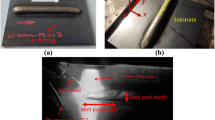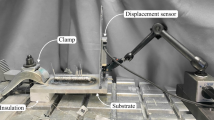Abstract
Electron beam additive manufacturing (EBAM) has broad application prospects in the preparation of large structural components such as those in aerospace structures. It is of great significance to have a deep understanding of the residual stress distribution and deformation of EBAM. A three-dimensional transient thermal–mechanical coupling model was established for the comprehensive investigation of the deformation and residual stress of aluminum alloy components prepared by wire-feed EBAM for the first time. The reliability of the simulation model was verified by comparing the predicted temperature, stress and deformation with experimentally measured values. The influence of heat input on residual stress distribution and deformation was studied using the verified model. The simulation results indicate that reducing heat input is an efficient approach to reducing deformation and residual stress. The developed model can be a powerful tool to optimize process parameters to reduce the residual stress and deformation of EBAM aluminum alloy components.















Similar content being viewed by others
References
Herzog D, Seyda V, Wycisk E, Emmelmann C (2016) Additive manufacturing of metals. Acta Mater 117:371–392. https://doi.org/10.1016/j.actamat.2016.07.019
Pu Z, Du D, Wang KM, Liu G, Zhang DQ, Wang XB, Chang BH (2021) Microstructure, phase transformation behavior and tensile superelasticity of NiTi shape memory alloys fabricated by the wire-based vacuum additive manufacturing. Mat Sci Eng A-Struct 812:141077. https://doi.org/10.1016/j.msea.2021.141077
Zhang DQ, Du D, Pu Z, Xue S, Qi JJ, Chang BH (2023) Interfacial microstructure and stress characteristics of laser-directed energy deposited AA2024 on Ti6Al4V substrate. Opt Laser Technol 164:109521. https://doi.org/10.1016/j.optlastec.2023.109521
Liu G, Du D, Wang KM, Pu Z, Zhang DQ, Chang BH (2021) High-temperature oxidation behavior of a directionally solidified superalloy repaired by directed energy deposition. Corros Sci 193:109918. https://doi.org/10.1016/j.corsci.2021.109918
Pu Z, Du D, Wang KM, Liu G, Zhang DQ, Zhang HY, Xi R, Wang XB, Chang B (2022) Study on the NiTi shape memory alloys in-situ synthesized by dual-wire-feed electron beam additive manufacturing. Addit Manuf 56:102886. https://doi.org/10.1016/j.addma.2022.102886
Wu BT, Pan ZX, Ding DH, Cuiuri D, Li HJ, Xu J, Norrish J (2018) A review of the wire arc additive manufacturing of metals: properties, defects and quality improvement. J Manuf Process 35:127–139. https://doi.org/10.1016/j.jmapro.2018.08.001
Zhu ZG, Hu ZH, Seet HL, Liu TT, Liao WH, Ramamurty U, Nai SML (2023) Recent progress on the additive manufacturing of aluminum alloys and aluminum matrix composites: Microstructure, properties, and applications. Int J Mach Tool Manu 190:104047. https://doi.org/10.1016/j.ijmachtools.2023.104047
Martin JH, Yahata BD, Hundley JM, Mayer JA, Schaedler TA, Pollock TM (2017) 3D printing of high-strength aluminum alloys. Nat 549:365–369. https://doi.org/10.1038/nature23894
Ghasemi A, Fereiduni E, Balbaa M, Jadhav SD, Elbestawi M, Habibi S (2021) Influence of alloying elements on laser powder bed fusion processability of aluminum: A new insight into the oxidation tendency. Addit Manuf 46:102145. https://doi.org/10.1016/j.addma.2021.102145
Weingarten C, Buchbinder D, Pirch N, Meiners W, Wissenbach K, Poprawe R (2015) Formation and reduction of hydrogen porosity during selective laser melting of AlSi10Mg. J Mater Process Technol 221:112–120. https://doi.org/10.1016/j.jmatprotec.2015.02.013
Bian HK, Aoyagi K, Zhao YF, Maeda C, Mouri T, Chiba A (2020) Microstructure refinement for superior ductility of Al-Si alloy by electron beam melting. Addit Manuf 32:100982. https://doi.org/10.1016/j.addma.2019.100982
Kenevisi MS, Lin F (2020) Selective electron beam melting of high strength Al2024 alloy; microstructural characterization and mechanical properties. J Alloy Compd 843:155866. https://doi.org/10.1016/j.jallcom.2020.155866
Utyaganova VR, Filippov AV, Shamarin NN, Vorontsov AV, Savchenko NL, Fortuna SV, Gurianov DA, Chumaevskii AV, Rubtsov VE, Tarasov SY (2020) Controlling the porosity using exponential decay heat input regimes during electron beam wire-feed additive manufacturing of Al-Mg alloy. Int J Adv Manuf Technol 108:2823–2838. https://doi.org/10.1007/s00170-020-05539-9
Raute J, Biegler M, Rethmeier M (2023) Process Setup and Boundaries of Wire Electron Beam Additive Manufacturing of High-Strength Aluminum Bronze. Metals 13:1416. https://doi.org/10.3390/met13081416
Pu Z, Du D, Zhang DQ, Li ZX, Xue S, Xi R, Wang XB, Chang BH (2023) Improvement of tensile superelasticity by aging treatment of NiTi shape memory alloys fabricated by electron beam wire-feed additive manufacturing. J Mater Sci Technol 145:185–196. https://doi.org/10.1016/j.jmst.2022.10.050
Li ZX, Cui YN, Chang BH, Liu G, Pu Z, Zhang HY, Liang ZY, Liu CM, Du D (2022) Manipulating molten pool in in-situ additive manufacturing of Ti-22Al-25 Nb through alternating dual-electron beams. Addit Manuf 60:103230. https://doi.org/10.1016/j.addma.2022.103230
Liang ZY, Chang BH, Zhang HY, Li ZX, Peng GD, Du D, Chang SH, Wang L (2022) Electric current evaluation for process monitoring in electron beam directed energy deposition. Int J Mach Tool Manu 176:103883. https://doi.org/10.1016/j.ijmachtools.2022.103883
Prabhakar P, Sames WJ, Dehoff R, Babu SS (2015) Computational modeling of residual stress formation during the electron beam melting process for Inconel 718. Addit Manuf 7:83–91. https://doi.org/10.1016/j.addma.2015.03.003
Simson T, Emmel A, Dwars A, Böhm J (2017) Residual stress measurements on AISI 316L samples manufactured by selective laser melting. Addit Manuf 17:183–189. https://doi.org/10.1016/j.addma.2017.07.007
Zhang WY, Guo D, Wang L, Davies CM, Mirihanage W, Tong MM, Harrison NM (2023) X-ray diffraction measurements and computational prediction of residual stress mitigation scanning strategies in powder bed fusion additive manufacturing. Addit Manuf 61:103275. https://doi.org/10.1016/j.addma.2022.103275
Swain D, Sharma A, Selvan SK, Thomas BP, Govind PJ (2019) Residual stress measurement on 3-D printed blocks of Ti-6Al-4V using incremental hole drilling technique. Procedia Struct Integr 14:337–344. https://doi.org/10.1016/j.prostr.2019.05.042
Sandmann P, Keller S, Kashaev N, Ghouse S, Hooper PA, Klusemann B, Davies CM (2022) Influence of laser shock peening on the residual stresses in additively manufactured 316L by Laser Powder Bed Fusion: A combined experimental–numerical study. Addit Manuf 60:103204. https://doi.org/10.1016/j.addma.2022.103204
Shen C, Ma Y, Reid M, Pan ZX, Hua XM, Cuiuri D, Paradowska A, Wang L, Li HJ (2022) Neutron diffraction residual stress determinations in titanium aluminide component fabricated using the twin wire-arc additive manufacturing. J Manuf Process 74:141–150. https://doi.org/10.1016/j.jmapro.2021.12.009
Nycz A, Lee Y, Noakes M, Ankit D, Masuo C, Simunovic S, Bunn J, Love L, Oancea V, Payzant A, Fancher CM (2021) Effective residual stress prediction validated with neutron diffraction method for metal large-scale additive manufacturing. Mater Des 205:109751. https://doi.org/10.1016/j.matdes.2021.109751
Sun JM, Hensel J, Köhler M, Dilger K (2021) Residual stress in wire and arc additively manufactured aluminum components. J Manuf Process 65:97–111. https://doi.org/10.1016/j.jmapro.2021.02.021
Zhao ZY, Wang JB, Du WB, Bai PK, Wu XY (2023) Numerical simulation and experimental study of the 7075 aluminum alloy during selective laser melting. Opt Laser Technol 167:109814. https://doi.org/10.1016/j.optlastec.2023.109814
Caiazzo F, Alfieri V, Bolelli G (2021) Residual stress in laser-based directed energy deposition of aluminum alloy 2024: simulation and validation. Int J Adv Manuf Technol 118:1197–1211. https://doi.org/10.1007/s00170-021-07988-2
Vastola G, Zhang G, Pei QX, Zhang YW (2016) Controlling of residual stress in additive manufacturing of Ti6Al4V by finite element modeling. Addit Manuf 12:231–239. https://doi.org/10.1016/j.addma.2016.05.010
Chen Z, Ye H, Xu HY (2018) Distortion control in a wire-fed electron-beam thin-walled Ti-6Al-4V freeform. J Mater Process Technol 258:286–295. https://doi.org/10.1016/j.jmatprotec.2018.04.008
Cao J, Gharghouri MA, Nash P (2016) Finite-element analysis and experimental validation of thermal residual stress and distortion in electron beam additive manufactured Ti-6Al-4V build plates. J Mater Process Technol 237:409–419. https://doi.org/10.1016/j.jmatprotec.2016.06.032
Raghavan N, Dehoff R, Pannala S, Simunovic S, Kirka M, Turner J, Carlson N, Babu SS (2016) Numerical modeling of heat-transfer and the influence of process parameters on tailoring the grain morphology of IN718 in electron beam additive manufacturing. Acta Mater 112:303–314. https://doi.org/10.1016/j.actamat.2016.03.063
Denlinger ER, Heigel JC, Michaleris P (2015) Residual stress and distortion modeling of electron beam direct manufacturing Ti-6Al-4V. P I Mech Eng B J Eng 229:1803–1813. https://doi.org/10.1177/0954405414539494
Chen GQ, Shu X, Liu JP, Zhang BG, Feng JC (2020) A new method for distortion calculations in additive manufacturing: contact analysis between a workpiece and clamps. Int J Mech Sci 171:105362. https://doi.org/10.1016/j.ijmecsci.2019.105362
Kruth JP, Deckers J, Yasa E, Wauthlé R (2012) Assessing and comparing influencing factors of residual stresses in selective laser melting using a novel analysis method. P I Mech Eng B J Eng 226:980–991. https://doi.org/10.1177/0954405412437085
Zhao L, Macías JGS, Dolimont A, Simar A, Rivière-Lorphèvre E (2020) Comparison of residual stresses obtained by the crack compliance method for parts produced by different metal additive manufacturing techniques and after friction stir processing. Addit Manuf 36:101499. https://doi.org/10.1016/j.addma.2020.101499
Acknowledgements
The authors would like to thank the editorial department and the reviewers.
Funding
This work was supported by the Joint Funds of China Academy of Launch Vehicle Technology and University (CALT 2021–24) and the Fund of the State Key Laboratory of Tribology in Advanced Equipment (SKLT2022C20).
Author information
Authors and Affiliations
Contributions
Conceptualization: Baohua Chang, Dongqi Zhang; methodology: Dong Du, Ze Pu; software: Dongqi Zhang, Yingying Tang; validation: Shuai Xue, Junjie Qi; formal analysis: Dongqi Zhang; investigation: Dongqi Zhang; resources: Yunpeng Lu, Baohua Chang; data curation: Dongqi Zhang; writing-original draft preparation: Dongqi Zhang; writing-review and editing: Baohua Chang; visualization: Baohua Chang; supervision: Dong Du; project administration: Dong Du, Yunpeng Lu; funding acquisition: Baohua Chang.
Corresponding author
Ethics declarations
Conflict of interest
The authors declare no conflict of interests.
Additional information
Publisher's Note
Springer Nature remains neutral with regard to jurisdictional claims in published maps and institutional affiliations.
Rights and permissions
Springer Nature or its licensor (e.g. a society or other partner) holds exclusive rights to this article under a publishing agreement with the author(s) or other rightsholder(s); author self-archiving of the accepted manuscript version of this article is solely governed by the terms of such publishing agreement and applicable law.
About this article
Cite this article
Zhang, D., Du, D., Xue, S. et al. Residual stress and deformation in wire-feed electron beam additive manufactured aluminum components. Int J Adv Manuf Technol 131, 1665–1676 (2024). https://doi.org/10.1007/s00170-024-13169-8
Received:
Accepted:
Published:
Issue Date:
DOI: https://doi.org/10.1007/s00170-024-13169-8




